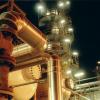While you have mentioned a flare system adequacy study, to me the key information is from the upstream/process side of the device where the upset is occurring.
Dynamic simulation would be one option to consider.
Anther option is to a time based calculation of system pressure, resulting from flow in, flow out and accumulation... you can make this as simple or complicated as you like.
But first consider/gathering the following bits of information.
Some details to consider
PSV release rate,
Is it a conventional valve? if the system pressure is above the set pressure, then you can consider the rated flow from the relief valve, only when the upstream pressure reduces will the valve close. This flow may be larger than the upset flow.
If its a modulating pilot, then the valve will only relieve the flow required to maintain the system pressure at the relief conditions, up to the rated flow of the device. As the upstream system pressure goes up and goes down (i.e. when the other CV open) then the flow will be proportional to this change. With the valve closing when the pressure drops to the set pressure (for simplicity)
Upset Flow,
The flow coming in causing the system to reach the PSV set pressure, is it considered constant for the duration of your assessment? or are there some variations
Extra CV.
When or how are they opened, manual based on a response to this PSV opening or based on pressure somewhere in the system (NOTE, i would really expect these CV to already be open before the relief valve not after)
Flow of this valve, assume its full open? or attempting to control to a pressure, which given the upset scenario, you could consider the full flow of the valve
Accumulation Calc / Process Safety Time Calc
Consider the scenario is simple blocks, at each step, there will be a starting and ending pressure. Work out the density at these conditions. Determine the accumulation flow of that step, then based on the density difference and the flow rate in, you can work out the time of each step (assuming constant system volume)
1. Upset flow only, flow is coming in, accumulating pressure in the system. If there is other flow out, then work out the difference of the flows which your accumulation flow.
2. PSV Opens, Work out the flow for this step (Flow in - Flow out of PSV), this will either maintain the pressure or reduce the pressure if the PSV flow out is > than the upset flow.
3. If pressure cycles, then repeat until the time or something occurs to open your control valve
4. CV Open, determine new net flow for the system (F in - F out PSV - F out CV), and consider flow until PSV closes (PSV set pressure).
5. CV Only, determine the flow of this scenario (F in - F out CV) ... take this through to an end point. Flow cold be modulating down CV could be controlling to some set point.
This should get you through the main steps of the scenario and give you a bit of information of the flow to the flare system for your adequacy check.

 FB
FB
 Posted by
Posted by

